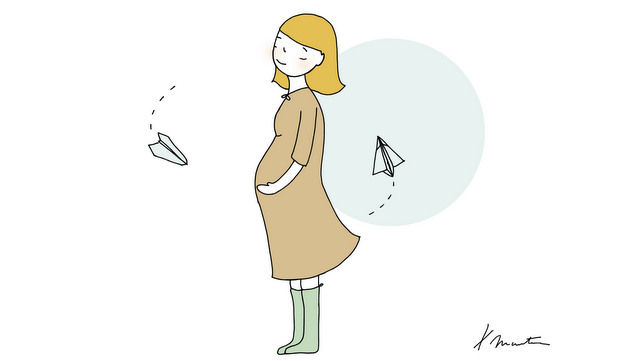Flying When Pregnant
 It is a common enough question: “Is it safe to fly when pregnant?” But choosing a one-word answer (yes or no) isn’t straightforward. When I answer this question, I usually reply, “Yes, but….”
It is a common enough question: “Is it safe to fly when pregnant?” But choosing a one-word answer (yes or no) isn’t straightforward. When I answer this question, I usually reply, “Yes, but….”
Postponing travel until a suitable time after giving birth may be the best option in many cases, but not necessarily the most practical. Flying when pregnant is likely to be an unavoidable situation for many women. Visiting family and friends overseas or travelling for business cannot always be avoided.
Thankfully, the majority of pregnancies are healthy and complication free, and a journey by plane is likely to be smooth and completely safe.
How many weeks pregnant are you?
Private airline companies are concerned about the chance of being forced to divert and make an unexpected landing if you go into labour. For this reason, most of the rules about flying when pregnant centre on how far along you are in your pregnancy.
There is no universal ruling and exact regulations vary from airline to airline, with the vast majority saying no flying after the end of 36 completed weeks of pregnancy (so, four weeks before your expected delivery date). This is because most (single) pregnancies make it through to at least 37 weeks. For a multiple pregnancy (twins or more), most airlines state no air travel after the end of 32 completed weeks of pregnancy.
Airlines don’t have restrictions if you are less than 28 weeks pregnant. See the table “A quick comparison of some airlines” at the end of this article for more information.
Carrying a letter once you get to 28 weeks is not a formal requirement but is strongly recommended. A letter from your obstetrician (or midwife) should confirm your expected delivery date, confirm how many babies you are carrying, and state that you have no health problems or complications preventing you from flying. Be aware: just because you have a letter, it doesn’t mean you will be allowed to fly. At the end of the day, an airline may still refuse to board you. If you haven’t reached 28 weeks yet, but look “obviously pregnant,” then it’s still worth having a letter with you.
What about flying during early pregnancy?
Travel by air does not increase the risk of you having a miscarriage.
If you must fly during the early weeks of pregnancy, make sure you have an ultrasound scan before you fly to check for an ectopic pregnancy. (An embryo implanting itself outside of the space in the womb may need treatment urgently.) Miscarriages are common, so invariably some women may have a miscarriage after a flight, but this does not happen because of the flight itself.
If you are unfortunate and have a miscarriage, being on a flight can of course make the situation more difficult to manage (emotionally, practically and financially).
Pregnancy, blood clots, and flying
There is a real risk of developing blood clots when pregnant, mainly because of the lack of movement when you’re sitting on a plane for hours. Keep your muscles moving to keep the blood flowing in your legs. If you don’t move your legs, blood pools and you get swelling. Not being mobile can lead to blood clots forming in your veins (deep vein thrombosis, DVT). This can also happen on long car or coach journeys.
Blood clot formation is worrying because bits of clot could travel to your lungs, and cause a serious condition called pulmonary embolism.
You can reduce the risk of developing blood clots by choosing an aisle seat, moving around as much as you can (every 30 minutes ideally, but at least every two hours). Walk up and down the aisle and do calf muscle exercises at your seat. Drink water and stay hydrated. Wear compression stockings (these press on your calf muscles to help improve blood flow in the deep veins of your legs. Note: stockings must fit you properly, so ask your midwife/obstetrician about them).
If your obstetrician thinks you have a higher risk of developing blood clots, you’ll need heparin injections, which you’ll be taught to give yourself. Heparin injections are not just for the flight itself – you’ll need to continue the injections for a number of days after the “risk” period, i.e., the time of immobility on the plane.
What happens if a pregnant woman goes into labour mid-flight?
The likelihood of you going into labour on a plane is tiny if you are within the less-than-37-weeks-pregnant-with-one-baby guideline and have had an uncomplicated pregnancy.
On board, you are relying on the help of the crew and your fellow passengers. It’s unlikely that any of these will be experienced enough to help you give birth safely. Medical equipment on board is limited.
As an aside, my (one) experience of responding to the, “Is there a doctor on board?” announcement was incredibly nerve-wracking. I was relieved that I could help the sick passenger (fortunately, it was something minor and had nothing to do with pregnancy). It certainly made me reflect on potential outcomes if adequate help isn’t available on a plane.
You may be lucky enough to share your flight with a midwife or an obstetrician.
Even so, regardless of whether you have had an “easy” birth before or not, there is no way of knowing how this particular birth will go, and there certainly aren’t facilities on board if your baby needs help.
When should a pregnant woman avoid flights?
This is a grey area, and decisions will vary according to individual factors. Special attention is needed for those with high blood pressure, heart disease, diabetes, epilepsy, severe anaemia, certain blood disorders, recent surgical procedures, and women who have previously gone into early labour.
Some other issues if you’re flying when pregnant
Travel insurance: take a good look at the small print so you are aware of exactly what will be covered.
Seat belt: this should be worn so that it’s under your tummy and lying across the tops of your thighs.
Cabin pressure: the air pressure on board is lower than it is at sea level. This means your blood picks up less oxygen. Healthy pregnant women can handle this well, but a pregnant woman with severe anaemia may be unable to cope.
Flying with a toddler: If you are pregnant and travelling with a child under two, it’s likely to be far too impractical and uncomfortable to have them on your lap with an extension belt attached, so you’ll probably need to buy an additional seat. Check the airline’s regulations about child seats, car seat regulations, etc.
Is there a “best time” to fly?
Yes, the second trimester (between the start of the 14th week to the end of the 27th week of pregnancy) is considered to be the safest and most comfortable time to fly, and you can feel confident about flying. However, don’t rely on “morning sickness” disappearing after the first trimester – you may book a flight for your second trimester, assuming that by then you’ll feel great, energetic and nausea-free (just like a textbook pregnancy), and then discover that you no longer want to fly.
In summary…
As mentioned at the start: yes, it is safe to fly when you’re pregnant. It just depends on the “but…” in your individual case. Why not write in about your experiences of flying when pregnant?
Disclaimer: This article is not intended to replace medical information provided by your own midwife or obstetrician. If you are pregnant, please seek advice for your specific situation.
By Dr Jahura Hossain
Born and brought up in London, Jahura is a U.K.-qualified doctor. She has worked in hospitals, general practice, public health, prison medicine, and the pharmaceutical industry.
© Copyright. Jahura Hossain. 2014. All rights reserved. No part of this article may be reproduced without the express consent of the author.
Illustration by Laura Munteanu
Laura has studied Journalism and Advertising, and has been working as a journalist and an illustrator. She has been illustrated for magazines, websites, charity and different campaigns. She lives in Zurich with her husband and her 5 year old daughter.
Table: A quick comparison of some airlines
(This information was accessed online on 10th March 2014. Please check in case of changes or updates).
| Airline | What they say about a single pregnancy without complications | What they say about a multiple pregnancy without complications
|
Letter requirement |
|
Swiss
|
Can fly up to the end of your 36th week of pregnancy
|
Can fly up to the end of your 32nd week of pregnancy
|
Carrying a letter is recommended beyond your 28th week
|
|
British Airways
|
Can fly up to the end of your 36th week of pregnancy |
Can fly up to the end of your 32nd week of pregnancy
|
Must carry letter if beyond your 28th week |
|
Qantas
|
Can fly up to the end of your 36th week of pregnancy (if flight is 4 hours duration or greater).
Can fly up to the end of the 40th week (if flight less than 4 hours duration)
|
Can fly up to the end of your 32nd week of pregnancy (if flight is 4 hours duration or greater).
Can fly up to the end of the 36th week (if flight less than 4 hours duration)
|
Must carry letter if beyond your 28th week |
|
American Airlines
|
Travel not advised within 30 days of your due date
(Travel within the US is permitted up to 7 days before your due date) |
Travel not advised within 30 days of your due date
|
If you are planning to travel within 30 days of your due date, you will need a doctor’s letter |



